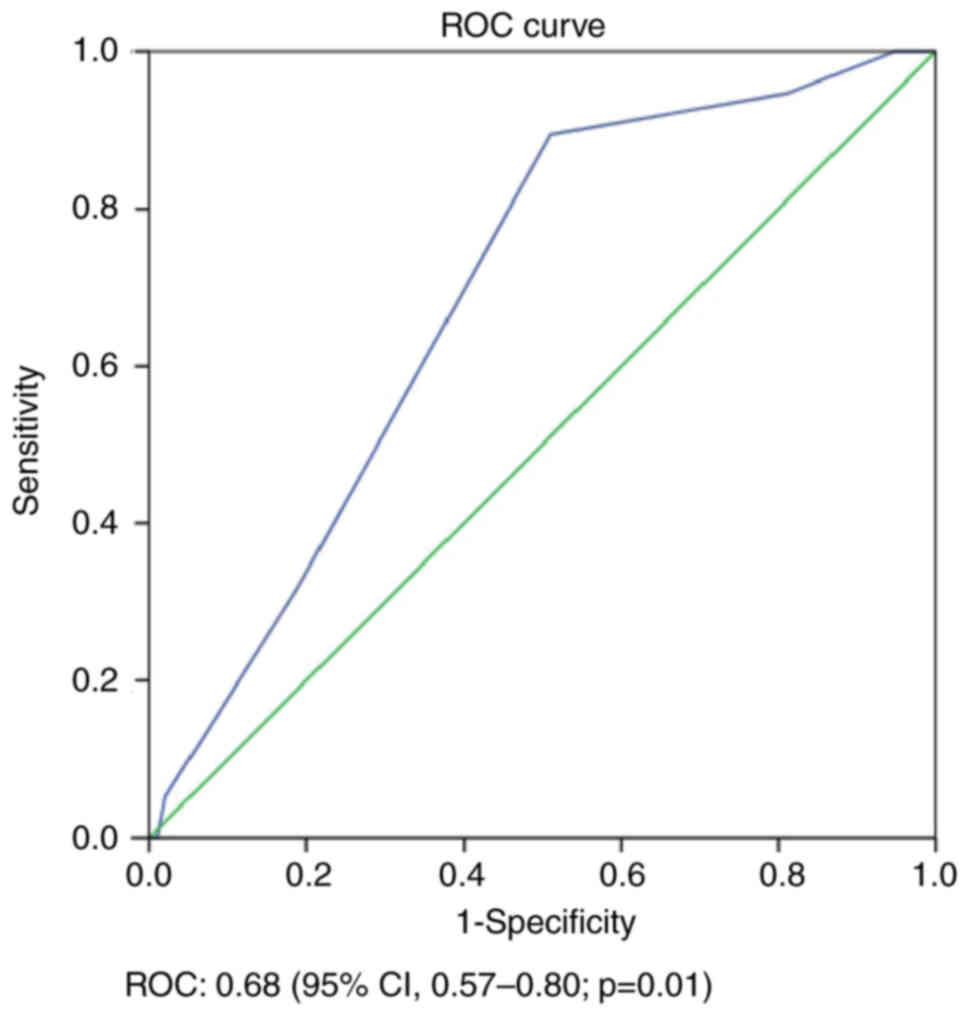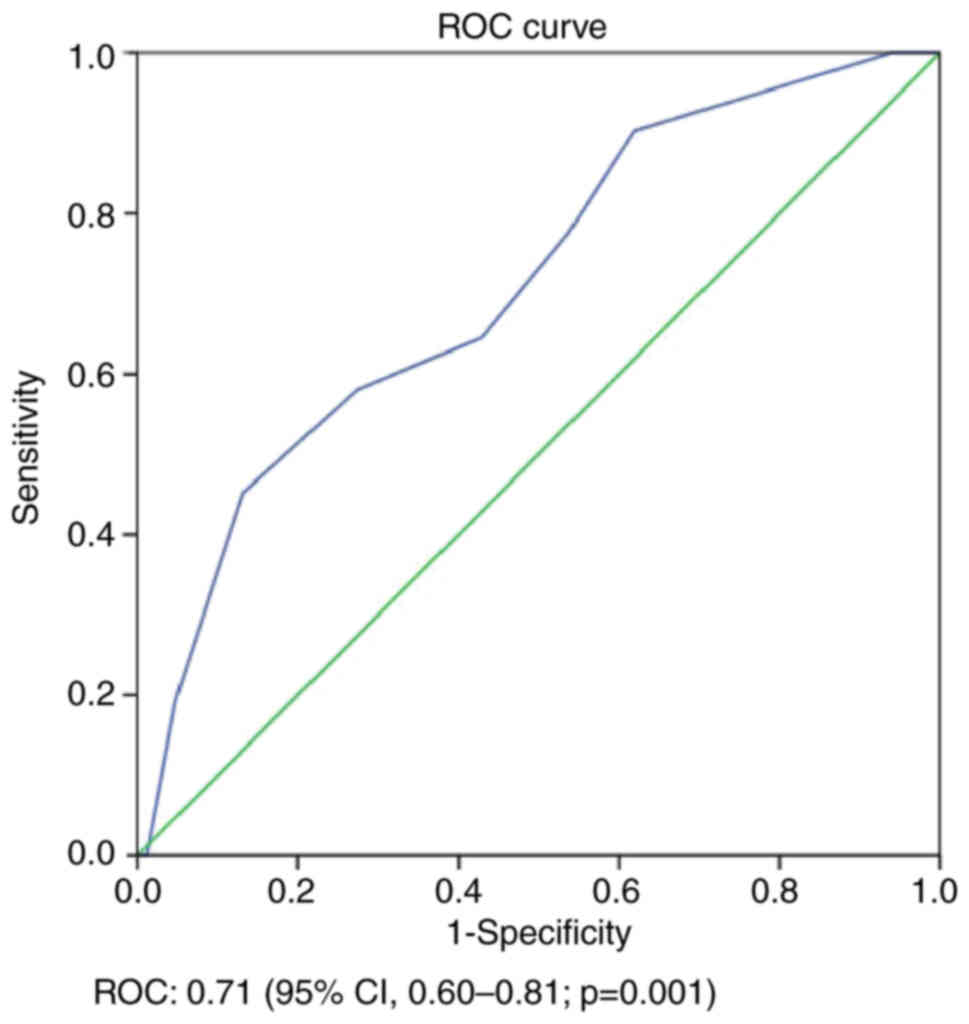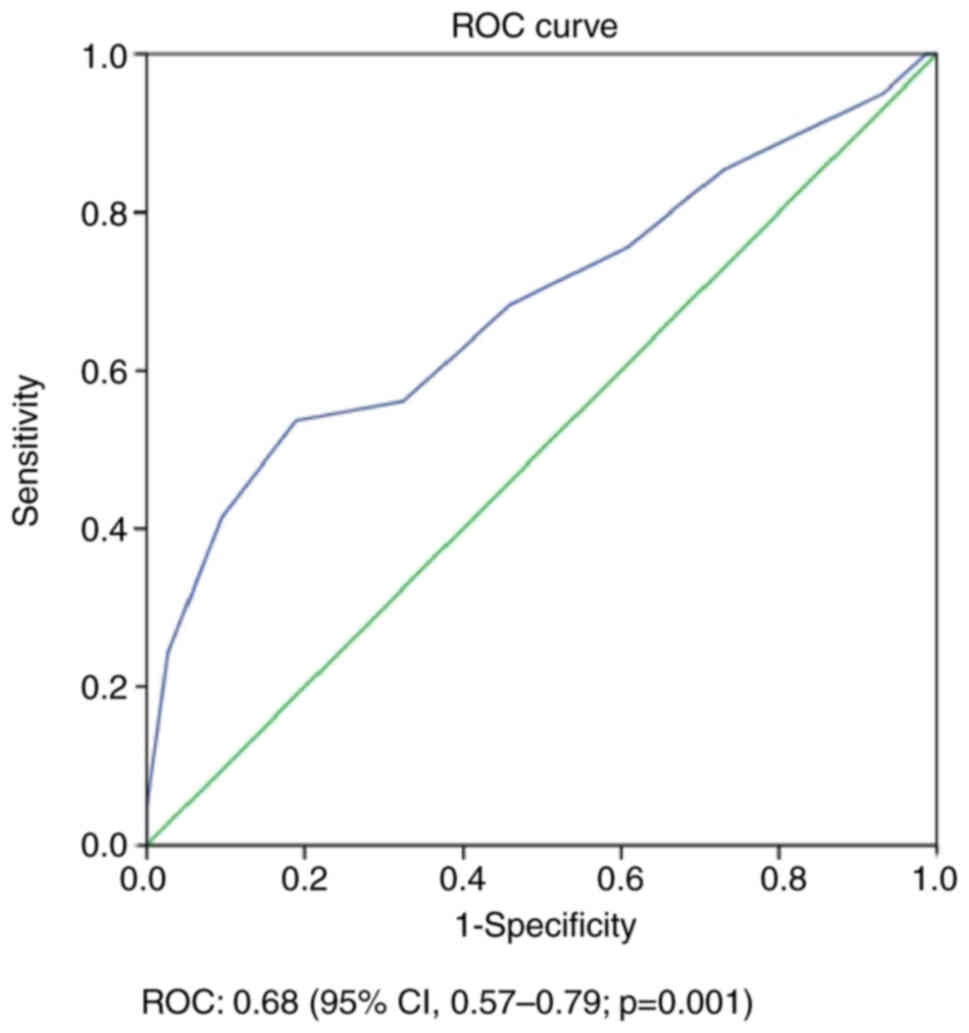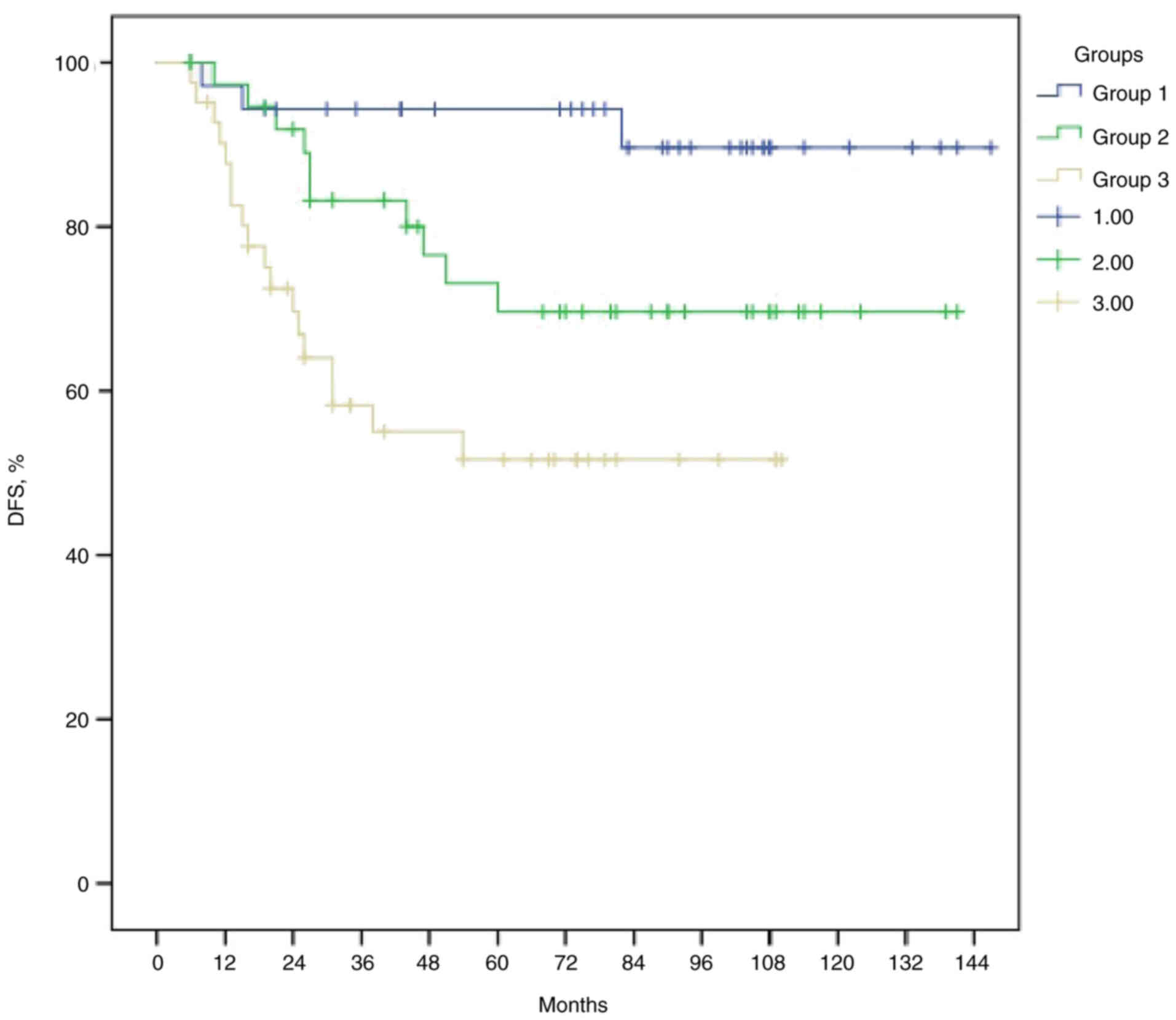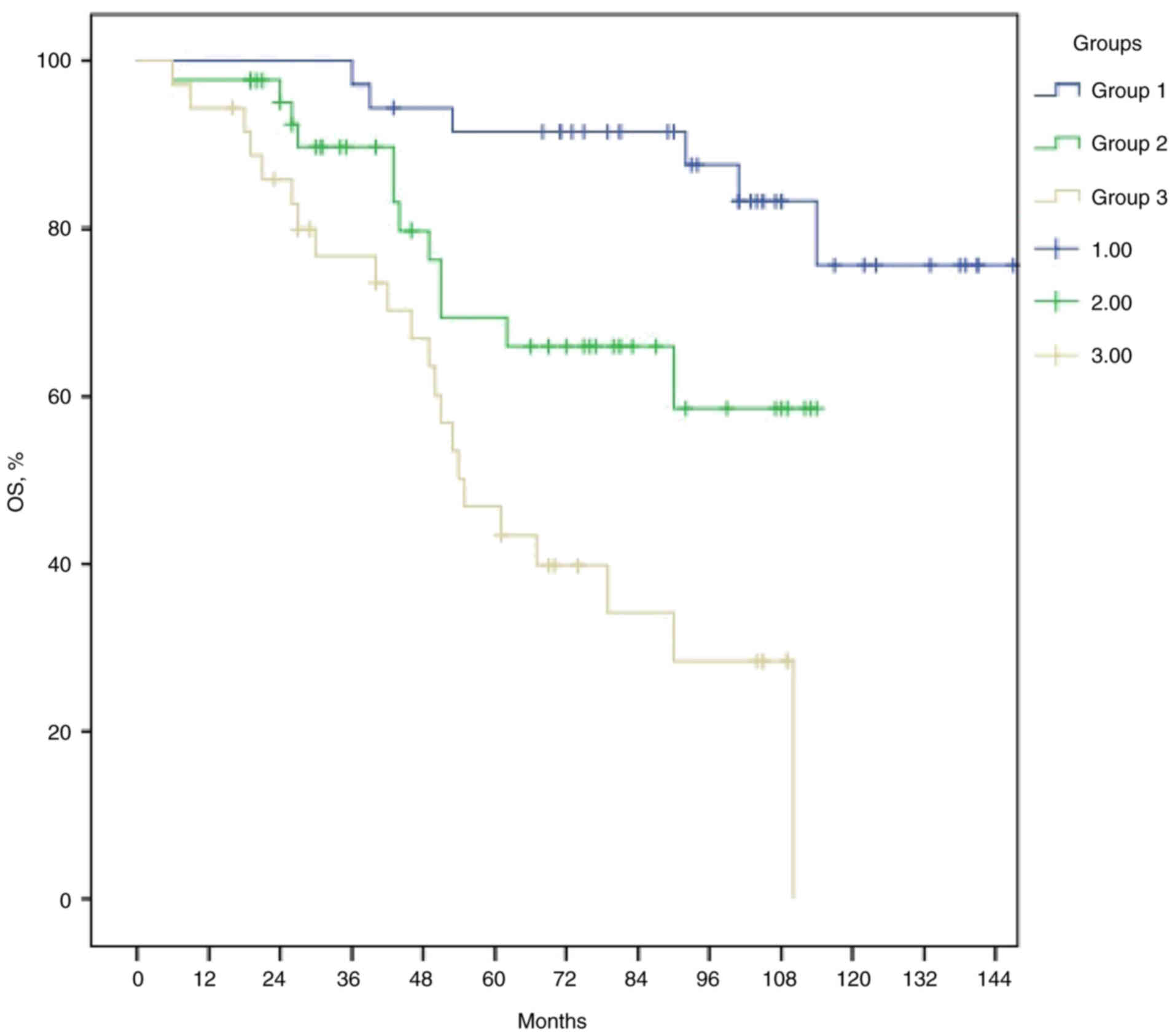|
1
|
Xi Y and Xu P: Global colorectal cancer
burden in 2020 and projections to 2040. Transl Oncol.
14:1011742021. View Article : Google Scholar : PubMed/NCBI
|
|
2
|
Glynne-Jones R, Wyrwicz L, Tiret E, Brown
G, Rödel Cd, Cervantes A and Arnold D; ESMO Guidelines Committee, :
Rectal cancer: ESMO clinical practice guidelines for diagnosis,
treatment and follow-up. Ann Oncol. 28:iv22–iv40. 2017. View Article : Google Scholar : PubMed/NCBI
|
|
3
|
Yang J, Deng Q, Cheng Y, Fu Z and Wu X:
Effect of adjuvant chemotherapy on the oncological outcome of
rectal cancer patients with pathological complete response. World J
Surg Oncol. 22:312024. View Article : Google Scholar : PubMed/NCBI
|
|
4
|
Johnson GG, Park J, Helewa RM, Goldenberg
BA, Nashed M and Hyun E: Total neoadjuvant therapy for rectal
cancer: A guide for surgeons. Can J Surg. 66:E1962023. View Article : Google Scholar : PubMed/NCBI
|
|
5
|
Neves ALF, Barbosa LER and Teixeira JPMdA:
Prognosis in colorectal cancer beyond TNM. J Coloproctology (Rio de
Janeiro). 40:404–411. 2020. View Article : Google Scholar
|
|
6
|
Zhang C, Yin S, Tan Y, Huang J, Wang P,
Hou W, Zhang Z and Xu H: Patient selection for adjuvant
chemotherapy in high-risk stage II colon cancer: A systematic
review and meta-analysis. Am J Clin Oncol. 43:279–287. 2020.
View Article : Google Scholar : PubMed/NCBI
|
|
7
|
Merkel S, Mansmann U, Papadopoulos T,
Wittekind C, Hohenberger W and Hermanek P: The prognostic
inhomogeneity of colorectal carcinomas stage III: A proposal for
subdivision of stage III. Cancer. 92:2754–2759. 2001. View Article : Google Scholar : PubMed/NCBI
|
|
8
|
Zhong JW, Yang SX, Chen RP, Zhou YH, Ye
MS, Miao L, Xue ZX and Lu GR: Prognostic value of lymphovascular
invasion in patients with stage III colorectal cancer: A
retrospective study. Med Sci Monit. 25:6043–6050. 2019. View Article : Google Scholar : PubMed/NCBI
|
|
9
|
Li Destri G, Maugeri A, Ramistella A, La
Greca G, Conti P, Trombatore G, Vecchio GM, Magro GG, Barchitta M
and Agodi A: The prognostic impact of neoadjuvant chemoradiotherapy
on lymph node sampling in patients with locally advanced rectal
cancer. Updates Surg. 72:793–800. 2020. View Article : Google Scholar : PubMed/NCBI
|
|
10
|
Baek JH, Baek DW, Kang BW, Kim HJ, Park
SY, Park JS, Choi GS and Kim JG: Prognostic impact of the
neoadjuvant rectal score as compared with the tumor regression
grade and yield pathologic TNM stage in patients with locally
advanced rectal cancer after neoadjuvant chemoradiotherapy. In
Vivo. 34:1993–1999. 2020. View Article : Google Scholar : PubMed/NCBI
|
|
11
|
Valentini V, Van Stiphout RG, Lammering G,
Gambacorta MA, Barba MC, Bebenek M, Bonnetain F, Bosset JF, Bujko
K, Cionini L, et al: Nomograms for predicting local recurrence,
distant metastases, and overall survival for patients with locally
advanced rectal cancer on the basis of European randomized clinical
trials. J Clin Oncol. 29:3163–3172. 2011. View Article : Google Scholar : PubMed/NCBI
|
|
12
|
Kim SM, Yoon G and Seo AN: What are the
most important prognostic factors in patients with residual rectal
cancer after preoperative chemoradiotherapy? Yeungnam Univ J Med.
36:124–135. 2019. View Article : Google Scholar : PubMed/NCBI
|
|
13
|
Dhadda A, Dickinson P, Zaitoun A, Gandhi N
and Bessell E: Prognostic importance of Mandard tumour regression
grade following pre-operative chemo/radiotherapy for locally
advanced rectal cancer. Eur J Cancer. 47:1138–1145. 2011.
View Article : Google Scholar : PubMed/NCBI
|
|
14
|
Valentini V, Gambacorta MA, Barbaro B,
Chiloiro G, Coco C, Das P, Fanfani F, Joye I, Kachnic L, Maingon P,
et al: International consensus guidelines on clinical target volume
delineation in rectal cancer. Radiother Oncol. 120:195–201. 2016.
View Article : Google Scholar : PubMed/NCBI
|
|
15
|
Hodapp N: The ICRU report 83: Prescribing,
recording and reporting photon-beam intensity-modulated radiation
therapy (IMRT). Strahlenther Onkol. 188:97–99. 2018. View Article : Google Scholar : PubMed/NCBI
|
|
16
|
Morini A, Annicchiarico A, Romboli A,
Ricco M, Crafa P, Montali F, Dell'Abate P and Costi R:
Retrospective survival analysis of stage II–III rectal cancer:
tumour regression grade, grading and lymphovascular invasion are
the only predictors. ANZ J Surg. 91:E112–E118. 2021. View Article : Google Scholar : PubMed/NCBI
|
|
17
|
Weiser MR: AJCC 8th edition: Colorectal
cancer. Ann Surg Oncol. 25:1454–1455. 2018. View Article : Google Scholar : PubMed/NCBI
|
|
18
|
Kim HG, Kim HS, Yang SY, Han YD, Cho MS,
Hur H, Min BS, Lee KY and Kim NK: Early recurrence after
neoadjuvant chemoradiation therapy for locally advanced rectal
cancer: Characteristics and risk factors. Asian J Surg. 44:298–302.
2021. View Article : Google Scholar : PubMed/NCBI
|
|
19
|
Dinaux AM, Leijssen L, Bordeianou LG,
Kunitake H, Amri R and Berger DL: Outcomes of persistent lymph node
involvement after neoadjuvant therapy for stage III rectal cancer.
Surgery. 163:784–788. 2018. View Article : Google Scholar : PubMed/NCBI
|
|
20
|
Chen K, Collins G, Wang H and Toh JWT:
Pathological features and prognostication in colorectal cancer.
Curr Oncol. 28:5356–5383. 2021. View Article : Google Scholar : PubMed/NCBI
|
|
21
|
Zhang C, Zhao S and Wang X: A prognostic
nomogram for T3N0 rectal cancer after total mesorectal excision to
help select patients for adjuvant therapy. Front Oncol.
11:6988662021. View Article : Google Scholar : PubMed/NCBI
|
|
22
|
Weiser MR, Chou JF, Keshinro A, Chapman
WC, Bauer PS, Mutch MG, Parikh PJ, Cercek A, Saltz LB, Gollub MJ,
et al: Development and assessment of a clinical calculator for
estimating the likelihood of recurrence and survival among patients
with locally advanced rectal cancer treated with chemotherapy,
radiotherapy, and surgery. JAMA Netw Open. 4:e21334572021.
View Article : Google Scholar : PubMed/NCBI
|
|
23
|
Chen HY, Feng LL, Li M, Ju HQ, Ding Y, Lan
M, Song SM, Han WD, Yu L, Wei MB, et al: College of American
pathologists tumor regression grading system for long-term outcome
in patients with locally advanced rectal cancer. Oncologist.
26:e780–e793. 2021. View Article : Google Scholar : PubMed/NCBI
|
|
24
|
Mandard AM, Dalibard F, Mandard JC, Marnay
J, Henry-Amar M, Petiot JF, Roussel A, Jacob JH, Segol P and Samama
G: Pathologic assessment of tumor regression after preoperative
chemoradiotherapy of esophageal carcinoma. Clinicopathologic
correlations. Cancer. 73:2680–2686. 1994. View Article : Google Scholar : PubMed/NCBI
|
|
25
|
Laohawiriyakamol S, Chaochankit W,
Wanichsuwan W, Kanjanapradit K and Laohawiriyakamol T: An
investigation into tumor regression grade as a parameter for
locally advanced rectal cancer and 5-year overall survival rate.
Ann Coloproctol. 39:59–70. 2022. View Article : Google Scholar : PubMed/NCBI
|
|
26
|
Capirci C, Valentini V, Cionini L, De
Paoli A, Rodel C, Glynne-Jones R, Coco C, Romano M, Mantello G,
Palazzi S, et al: Prognostic value of pathologic complete response
after neoadjuvant therapy in locally advanced rectal cancer:
Long-term analysis of 566 ypCR patients. Int J Radiat Oncol Biol
Phys. 72:99–107. 2008. View Article : Google Scholar : PubMed/NCBI
|
|
27
|
Liebig C, Ayala G, Wilks JA, Berger DH and
Albo D: Perineural invasion in cancer: A review of the literature.
Cancer. 115:3379–3391. 2009. View Article : Google Scholar : PubMed/NCBI
|
|
28
|
Knijn N, Mogk SC, Teerenstra S, Simmer F
and Nagtegaal ID: Perineural invasion is a strong prognostic factor
in colorectal cancer. Am J Surg Pathol. 40:103–112. 2016.
View Article : Google Scholar : PubMed/NCBI
|
|
29
|
Lin Y: A prognostic nomogram for stage
II/III rectal cancer patients treated with neoadjuvant
chemoradiotherapy followed by surgical resection. BMC Surg.
22:2562022. View Article : Google Scholar : PubMed/NCBI
|
|
30
|
Feng H, Lyu Z, Zheng J, Zheng C, Wu DQ,
Liang W and Li Y: Association of tumor size with prognosis in colon
cancer: A surveillance, epidemiology, and end results (SEER)
database analysis. Surgery. 169:1116–1123. 2021. View Article : Google Scholar : PubMed/NCBI
|
|
31
|
Yan Q, Zhang K, Guo K, Liu S, Wasan HS,
Jin H, Yuan L, Feng G, Shen F, Shen M, et al: Value of tumor size
as a prognostic factor in metastatic colorectal cancer patients
after chemotherapy: A population-based study. Future Oncol.
15:1745–1758. 2019. View Article : Google Scholar : PubMed/NCBI
|
|
32
|
Dai W, Li Y, Meng X, Cai S, Li Q and Cai
G: Does tumor size have its prognostic role in colorectal cancer?
Re-evaluating its value in colorectal adenocarcinoma with different
macroscopic growth pattern. Int J Surg. 45:105–112. 2017.
View Article : Google Scholar : PubMed/NCBI
|
|
33
|
Jiang Y, You K, Qiu X, Bi Z, Mo H, Li L
and Liu Y: Tumor volume predicts local recurrence in early rectal
cancer treated with radical resection: A retrospective
observational study of 270 patients. Int J Surg. 49:68–73. 2018.
View Article : Google Scholar : PubMed/NCBI
|
|
34
|
Tayyab M, Razack A, Sharma A, Gunn J and
Hartley JE: Correlation of rectal tumor volumes with oncological
outcomes for low rectal cancers: Does tumor size matter? Surg
Today. 45:826–833. 2015. View Article : Google Scholar : PubMed/NCBI
|
|
35
|
Yeo SG, Kim DY, Park JW, Oh JH, Kim SY,
Chang HJ, Kim TH, Kim BC, Sohn DK and Kim MJ: Tumor volume
reduction rate after preoperative chemoradiotherapy as a prognostic
factor in locally advanced rectal cancer. Int J Radiat Oncol Biol
Phys. 82:e193–e199. 2012. View Article : Google Scholar : PubMed/NCBI
|
|
36
|
McCarthy K, Pearson K, Fulton R and Hewitt
J: Pre-operative chemoradiation for non-metastatic locally advanced
rectal cancer. Cochrane Database Syst Rev.
12:CD0083682012.PubMed/NCBI
|
|
37
|
Jin J, Tang Y, Hu C, Jiang LM, Jiang J, Li
N, Liu WY, Chen SL, Li S, Lu NN, et al: Multicenter, randomized,
phase III trial of short-term radiotherapy plus chemotherapy versus
long-term chemoradiotherapy in locally advanced rectal cancer
(STELLAR). J Clin Oncol. 40:1681–1692. 2022. View Article : Google Scholar : PubMed/NCBI
|
|
38
|
Bahadoer RR, Dijkstra EA, van Etten B,
Marijnen CA, Putter H, Kranenbarg EMK, Roodvoets AGH, Nagtegaal ID,
Beets-Tan RGH, Blomqvist LK, et al: Short-course radiotherapy
followed by chemotherapy before total mesorectal excision (TME)
versus preoperative chemoradiotherapy, TME, and optional adjuvant
chemotherapy in locally advanced rectal cancer (RAPIDO): A
randomised, open-label, phase 3 trial. Lancet Oncol. 22:29–42.
2021. View Article : Google Scholar : PubMed/NCBI
|
|
39
|
Dijkstra EA, Nilsson PJ, Hospers GA,
Bahadoer RR, Kranenbarg EM-K, Roodvoets AG, Putter H, Berglund Å,
Cervantes A, Crolla RMPH, et al: Locoregional failure during and
after short-course radiotherapy followed by chemotherapy and
surgery compared to long-course chemoradiotherapy and surgery-a
five-year follow-up of the RAPIDO trial. Ann Surg. 278:e766–e772.
2023. View Article : Google Scholar : PubMed/NCBI
|
|
40
|
Conroy T, Bosset JF, Etienne PL, Rio E,
François É, Mesgouez-Nebout N, Vendrely V, Artignan X, Bouché O,
Gargot D, et al: Neoadjuvant chemotherapy with FOLFIRINOX and
preoperative chemoradiotherapy for patients with locally advanced
rectal cancer (UNICANCER-PRODIGE 23): A multicentre, randomised,
open-label, phase 3 trial. Lancet Oncol. 22:702–715. 2021.
View Article : Google Scholar : PubMed/NCBI
|
|
41
|
Diao JD, Wu CJ, Cui HX, Bu MW, Yue D, Wang
X, Liu YL and Yang YJ: Nomogram predicting overall survival of
rectal squamous cell carcinomas patients based on the SEER
database: A population-based STROBE cohort study. Medicine
(Baltimore). 98:e179162019. View Article : Google Scholar : PubMed/NCBI
|



